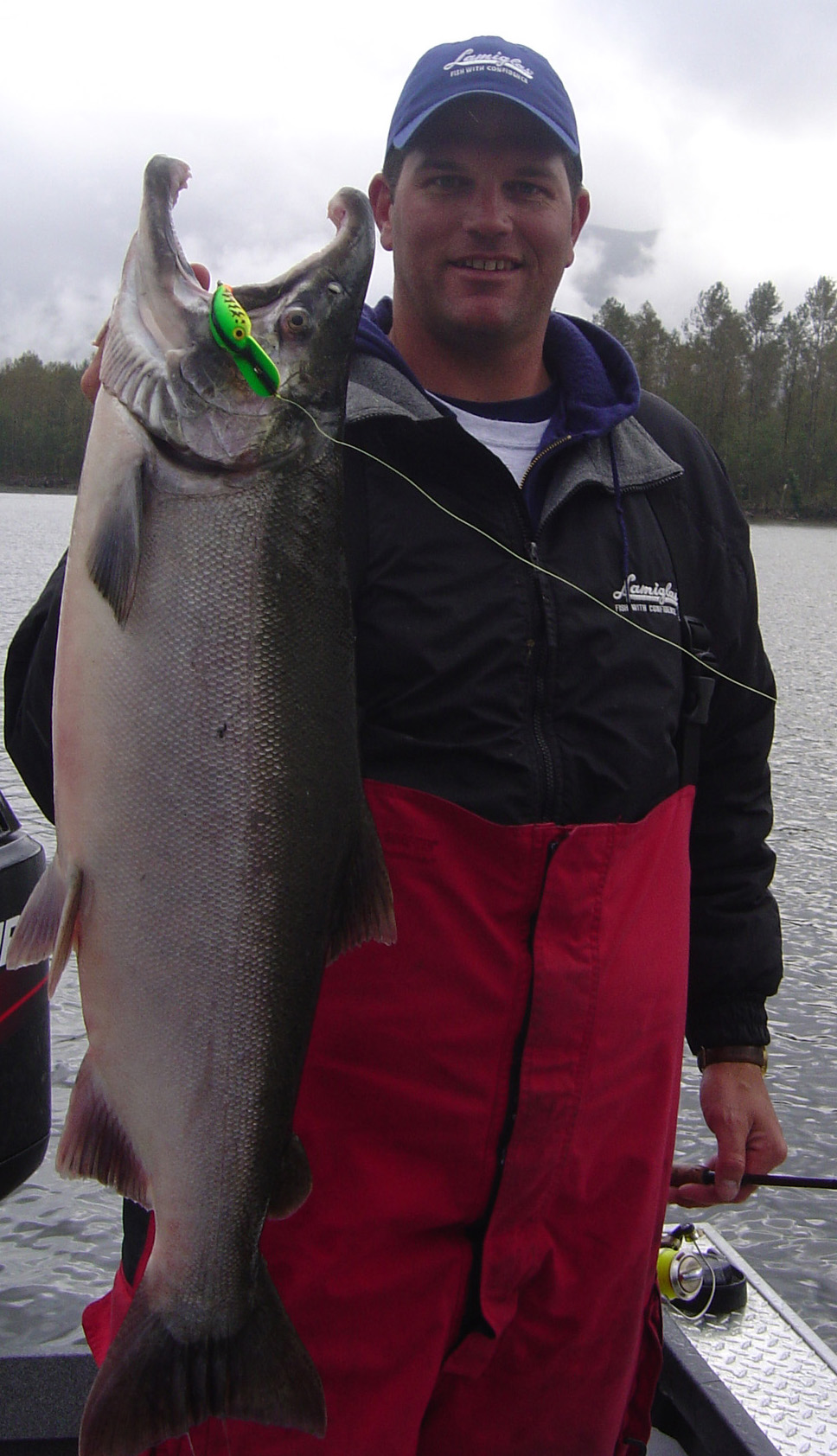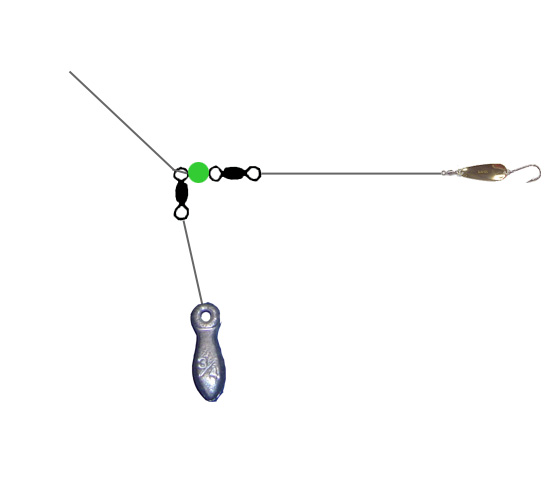Pull Out the Hardware for Early Season Silvers 5
It's September 6th here in Seattle, Washington and guess what…it's raining!
For those of us nut-cakes that grew up in the soggy Northwest this early rain means one thing, that salmon will be hitting the rivers pronto. It actually means more than that, but for the purpose of this blog and to keep my A.D.D. in check I'll stick with salmon and specifically, early silvers.
Early silvers headed for North Puget Sound rivers like the Snohomish, Stilliguamish, and Skagit systems are programmed to hammer hardware once they get their first sniff of freshwater. Vibrax and Mepp spinners in size 4’s and 5’s, Dick Nite spoons, and Wiggle Warts will all get the attention of an aggressive silver that just hit the river. These fish are still agressive and the flash, buzz, and rattle of hardware is what they're lookin' for.

Cover Water
Early silvers are usually on the move, especially if the water is up, so it’s sometimes necessary to cover a ton of water to find schools heading upstream. I usually do this by casting Vibrax or Mepps spinners from a drifting jet sled or driftboat, pitching into any water that is deep and slow moving with woody cover nearby. The second water I look for when using this run-and-gun technique is large gravel bars with deeper water over them that silvers will use as a travel lane as they make their way upstream.
Holding the boat away from the area I want to fish so I don't spook the fish, I’ll use the kicker motor or oars to control the drift and slow the boat down and cast large spinners, usually number 5’s, at a forty five degree angle upstream. Let the spinner sink into the fish-holding zone and then give the rod a slight pop to get the blade rotating, reeling just fast enough to keep the blade rotating as slowly as possible near the bottom on the retrieve. The nice thing about using big spinners early in the season is that they can be seen and heard from a distance. It's an awesome way to cover a lot of water when fish are scattered.
Most strikes will occur just after the spinner starts rotating, but it’s surprising how many fish will follow the spinner all the way to the boat before crushing it. Moral to the story…don't give up until the spinner is out of the water.
Kegged Up Silvers
If silvers are rolling in an area, especially in a deep pool, it’s usually because they’ve stopped to hold before moving upstream. While casting spinners can sometimes get a bite from these fish, it’s usually best to anchor up away from the fish and cast Dick Nite spoons, Wiggle Warts, or Jigs into the zone where the silvers are holding.
Dick Nite spoons are deadly in low and clear water and are sometimes about all that these fickle silvers will hit when the water gets gin-clear during long periods with little or no rain in the fall. The Half and Half is the most popular spoon in the fall, but don't overlook the glow, frog pattern and silver/chartruese and silver/red. In super low water you'd be surprised how many fish will hit the Wee Dick Nite and in medium to high flows the size #1 and #2's get the job done.

Wiggle Warts or Brads Wigglers can also be backtrolled from a boat. Fish them just like you would for steelhead, backtrolling them downstream thru a salmon-holding run and then, if there's a lot of fish in the run, row or use the kicker motor to troll the plugs all the way back to the top of the run. You'd be surprised how many silvers will ONLY hit the plugs when they're going back upstream.
High Water Haunts
I can actually write about one of my favorite coho haunts now because it no longer exists. A large lake would form in a backwater area on the lower Skagit in the fall when the flows would come up and essentially blow the river out. My customers would always question my judgment as we launched the boat onto a swollen, muddy river, and I would have to reassure them that they could go home for free if the fishing didn’t pan out.
This area was a guarded secret of mine for several years and we would often be home for breakfast with easy limits of silver salmon from this huge backwater area. The action was phenomenal, but only on extremely high water when schools of moving silvers would get flushed out of the main river channel and into this protected area.
This “lake” was actually an old oxbow that would stack the silvers up when the river would get extremely high with early fall rains. We would fish this area exactly like we were fishing for bass, puttering around on the kicker motor and launching Wiggle Warts every which way but loose. This provided white hot coho action for three years until a big flood eventually filled in the big oxbow with silt, but for those few years it was some of the best silver fishing I’ve ever seen in the freshwater.
Even though most of the North Sound rivers are hardened with rock walls and dikes there's still plenty of these backwater areas that hold up big numbers of coho in high water. When the rivers get jacked up in the fall after a big rain the fish pour into these areas to get away from silt, debris, and the high flows that reach from bank to bank.
Low Water Haunts
The "frog" water is where you'll find most of the coho's piled up in the fall. Those big back eddy's that go around in slow circles that never seem to hold any steelhead…yup, that's one place to look. And as I mentioned earlier, carpet-bomb any deep, slow area that's got a bunch of woody debris in it. Downed trees, root wads, and backwater areas behind log jams are excellent places to find silver salmon.
Conversely, also look at the very top of fast, deep chutes when the water gets super low and vodka clear. Areas like this can act like a fish trap, stacking up fish reluctant to head upstream.
If you find the mother-lode of silver salmon rolling in a deep hole in low water hunker down and stay for a while. Throw the book at'em and if they don't bite get there at the crack of dawn the next day and give'em a go early in the day. Silvers can be finnicky as all get out and sometimes they "go" early in the morning and then lock down for the rest of the day.
I've been back from Alaska for exactly 6 days and I'm already tuned up to hammer salmon on our Northwest rivers this fall. After a tuna trip with Tobeck and a couple of sneaky summer steelhead jams it'll be time to dust off the spinners and crack open that ol' box of Dick Nite's.


Well, if you would ever read and comment on one of my blogs you might learn something...
Another informative and educational blog from Robbo. When are you going to write one of those Nelly?
Roger that E! We had some wide open action there for a few years and that day in particular was nuts.
You can't start your blog out bitching about the rain like I did! Dude, it's fall. Plain and simple. With this precip, the rivers will be callin' the coho home quicker than usual. I would not be surprised if the majority of the top ten fish in the Everett Coho Derby came from the rivers this year!
Hey, that first picture looks awfully famililar. That was a banner day if I do recall. Uncle T would even remember that day!